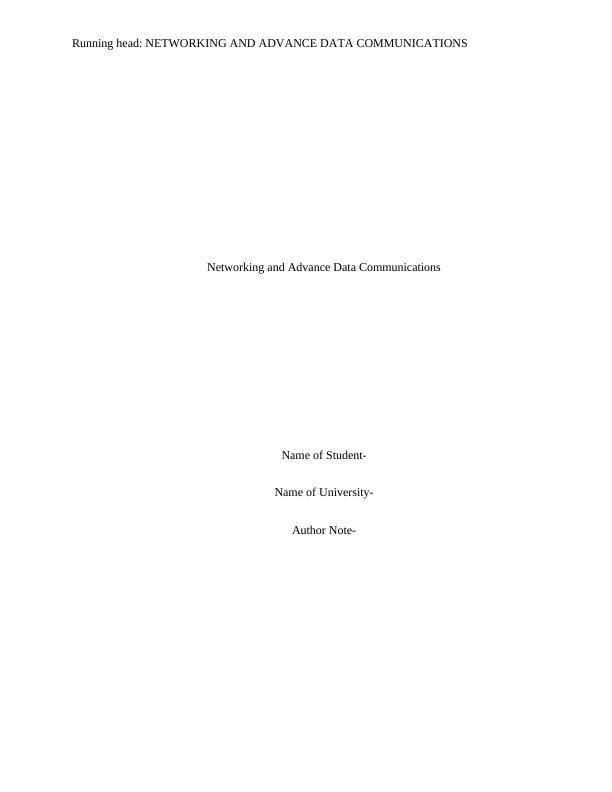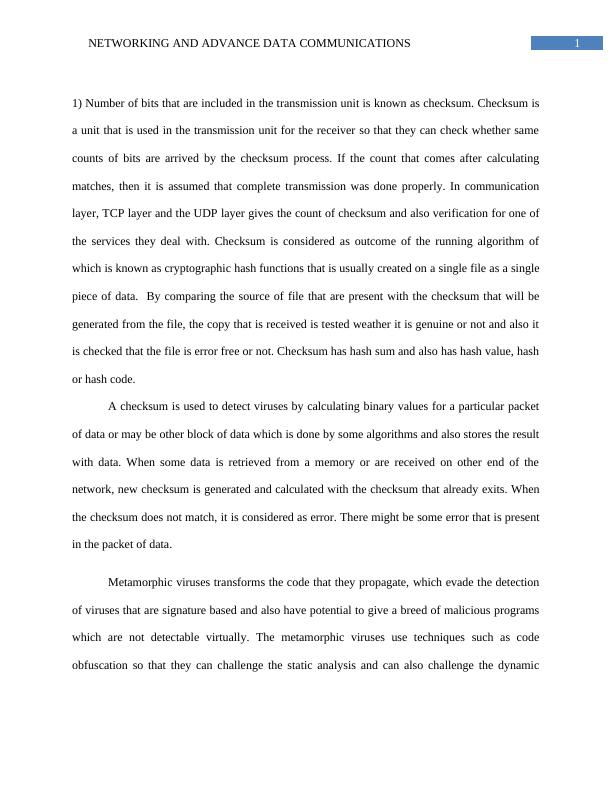Ask a question from expert
Networking and Advance Data Communications
12 Pages1571 Words116 Views
Added on 2020-04-21
Networking and Advance Data Communications
Added on 2020-04-21
BookmarkShareRelated Documents
Running head: NETWORKING AND ADVANCE DATA COMMUNICATIONSNetworking and Advance Data CommunicationsName of Student-Name of University-Author Note-

1NETWORKING AND ADVANCE DATA COMMUNICATIONS1) Number of bits that are included in the transmission unit is known as checksum. Checksum isa unit that is used in the transmission unit for the receiver so that they can check whether samecounts of bits are arrived by the checksum process. If the count that comes after calculatingmatches, then it is assumed that complete transmission was done properly. In communicationlayer, TCP layer and the UDP layer gives the count of checksum and also verification for one ofthe services they deal with. Checksum is considered as outcome of the running algorithm ofwhich is known as cryptographic hash functions that is usually created on a single file as a singlepiece of data. By comparing the source of file that are present with the checksum that will begenerated from the file, the copy that is received is tested weather it is genuine or not and also itis checked that the file is error free or not. Checksum has hash sum and also has hash value, hashor hash code. A checksum is used to detect viruses by calculating binary values for a particular packetof data or may be other block of data which is done by some algorithms and also stores the resultwith data. When some data is retrieved from a memory or are received on other end of thenetwork, new checksum is generated and calculated with the checksum that already exits. Whenthe checksum does not match, it is considered as error. There might be some error that is presentin the packet of data. Metamorphic viruses transforms the code that they propagate, which evade the detectionof viruses that are signature based and also have potential to give a breed of malicious programswhich are not detectable virtually. The metamorphic viruses use techniques such as codeobfuscation so that they can challenge the static analysis and can also challenge the dynamic

2NETWORKING AND ADVANCE DATA COMMUNICATIONSanalyzers which include emulators. These are done by changing their behavior when the virusdetect that they are mainly executing under an environment that is fully controlled.

3NETWORKING AND ADVANCE DATA COMMUNICATIONS2) SYN Flood3) Trusted relationships can be voided by Trojan horse which is a virus that records all thematerials that the user types in their system and send all the data back to hackers. It also sendsemails that are spam for attacking other computers.4) None of the above because the attack which modifies the DNS of the website is the spoofingattack. 5) Denial of service attack is the type of attack that crashes the system server.6) DOS and DDOS attack7) True because without knowing the system configuration, the attackers will not be able totarget the organization. The hactivists must have the configuration of the system. 8) DDOS attacks because these attacks carries actors of diverse threat that ranges from criminalhackers to crime rings and the government attacks that are organized. In those situations, theDDOS relate with poor coding, unstable systems and also misses patches. 9) RootkitThere is a need of separation of duties because the separation of duties has two mainobjectives. The conflict that arises regarding the interest, appearance of the interest, wrong acts,frauds, errors and abuse are all prevented. The control failure that occurs including the security

End of preview
Want to access all the pages? Upload your documents or become a member.
Related Documents
OSI Layerslg...
|22
|3449
|73
Data Link Layer, Transport Layer, Cloud Computing and Networklg...
|12
|2301
|198
OSI Model and TCP/IP Model: A Comparisonlg...
|4
|787
|271
Wireless Networks & Communication INTRODUCTIONlg...
|7
|1967
|200
Communication Networkslg...
|49
|5951
|90
Information Security Technologieslg...
|4
|805
|44